Why it’s important
All too often, we want take action based on perceived problems or long held beliefs that certain actions will result in the outcomes we desire. It’s important to understand your problem at a deeper level, and data is the best tool you have at your disposal. Data allows you to narrow in and focus, take a deeper dive and discover the root cause to your perceived issue. If you arrive at the root cause correctly, you’ll be able to strategize and apply the most appropriate solution.
What people can expect to see
Sometimes people make changes based on feelings and perceptions. Sometimes people have preconceived notions about problems that may or may not exist (in the absence of data, it’s impossible to tell!). With the proper data collection and the proper application of collected data, you should be able to perform a much more concise and focused root cause analysis (RCA). This more focused RCA, in turn, will lead you to more effective and sustainable solutions. Continuous data will also allow you to determined the level of success your solution has had, and adjust accordingly.
Any good solution to any bad problem begins with knowing how bad the problem is (data!), how much you think you can improve it (data!), your RCA (from the data!), and how much you actually improved (data!).
In a Six Sigma setting, we might utilize mini-tab or JMP for data collection, but you don’t need special software to get started building your data set. A simple Excel spreadsheet will do nicely, and you can branch out to Pareto charts, scatter or pie charts and/or histograms when you have more experience and more data to work with.
__
About Chris Hartley:
 Chris has a passion for bringing Lean to healthcare and government clients; he partners with hospitals, physician’s offices, public health departments, and government agencies as both a guide and mentor, coaching personnel to become Lean leaders within their organizations. Chris has led Kaizen teams to see dramatic decreases in throughput in hospital emergency departments; decreases in time to hire for human resource departments; and increases in capacity and production for government agencies. Chris has over 15 years of process improvement and project management experience in government, hospital, and laboratory service industries, and is a certified Lean Six Sigma Green Belt.
Chris has a passion for bringing Lean to healthcare and government clients; he partners with hospitals, physician’s offices, public health departments, and government agencies as both a guide and mentor, coaching personnel to become Lean leaders within their organizations. Chris has led Kaizen teams to see dramatic decreases in throughput in hospital emergency departments; decreases in time to hire for human resource departments; and increases in capacity and production for government agencies. Chris has over 15 years of process improvement and project management experience in government, hospital, and laboratory service industries, and is a certified Lean Six Sigma Green Belt.



